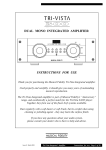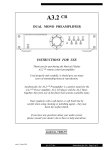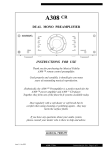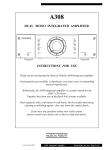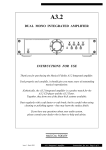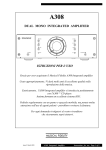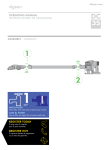Download Musical Fidelity Tri-Vista Specifications
Transcript
Tri-Vista PREAMPLIFIER INSTRUCTIONS FOR USE Thank you for purchasing the Musical Fidelity Tri-Vista Pre remote control preamplifier. Used properly and carefully, it should give you many years of outstanding musical reproduction. Aesthetically, the Tri-Vista Pre is a perfect match for the Tri-Vista Power amplifier and Tri-Vista SACD player, which are part of our 20th Anniversary series. Together, they form one of the finest hi-fi systems available today. Dust regularly with a soft duster or soft brush but be careful when using cleaning or polishing agents - they may harm the surface finish. If you have any questions about your audio system, please consult your dealer who is there to help and advise. Issue 1: April 2003 Tri-Vista Pre Instructions for Use Page 1 of 11 SAFETY INFORMATION IMPORTANT! (U.K. only) This unit is supplied in the U.K. with a mains lead fitted with a moulded 13 amp plug. If, for any reason, you need to cut off this plug, please remove the fuse holder and dispose of the plug safely, out of reach of children. It must not be plugged into a mains outlet. The wires in the mains lead supplied with this appliance are coloured in accordance with the following code: Green and yellow..............Earth Blue...............................Neutral Brown................................Live WARNING - This appliance must be earthed As the colours of the wires of the mains lead of this appliance may not correspond with the coloured markings identifying the terminals in your plug, proceed as follows: The wire which is coloured green-and-yellow must be connected to the terminal in the plug which is marked with the letter E or coloured green or green-and-yellow, or by the earth symbol: The wire which is coloured brown must be connected to the terminal which is marked with the letter L or coloured red. The wire which is coloured blue must be connected to the terminal which is marked with the letter N or coloured black. If connecting to a BS1363 plug, a 13 amp fuse must be used. WARNING: Any modifications to this product not expressly approved by Musical Fidelity who is the party responsible for standards compliance could void the user’s authority to operate this equipment. Issue 1: April 2003 Tri-Vista Pre Instructions for Use Page 2 of 11 GENERAL ADVICE INSTALLATION PRECAUTIONS and USER INFORMATION Your new Tri-vista Pre-amplifier is designed and built to provide trouble-free performance, but as with all electronic devices it is necessary to observe a few precautions: Heed all warnings shown on the back of the product. Only connect the Tri-vista Pre-amplifier to a mains outlet having the same voltage as marked at the back of the unit. Always ensure that when disconnecting and reconnecting your audio equipment the mains supply is switched off. Position the mains lead and signal interconnects where they are not likely to be walked on or trapped by items placed on them. Do not use near water, or place water-filled containers on the pre-amplifier, for example, flower vases or potted plants. If water does spill inside, immediately pull out the mains plug from the wall socket and inform your dealer, who should then check the unit before further use. Entry of liquid into the pre-amplifier is dangerous, and may cause electric shock or fire hazard. Do not place the units near heat sources such as radiators, direct sunlight or other equipment - operate them in a well ventilated area. Do not remove covers or try to gain access to the inside. There are no internal user adjustments. Refer all service work to an authorised Musical Fidelity agent. NOTE: Unauthorised opening of the equipment will invalidate any warranty claims. There are fuses inside the Tri-vista Pre-amplifier. In the unlikely event that one blows, refer the unit to your audio dealer. Do NOT try to replace the fuse yourself as this will invalidate the warranty. Dust regularly with a soft duster or soft brush, but be careful when using cleaning or polishing agents - they may harm the surface finish. The electronics in modern hi-fi equipment is complex and may, therefore, be adversely affected or damaged by lightning. For protection of your audio system during electrical storms, remove the mains plugs and disconnect any aerial lead. If after-sales service is required, to help your dealer identify the Tri-vista Pre, please quote the serial number located on the rear panel of the unit. RADIO FREQUENCY INTERFERENCE (R.F.I) This product has been tested to ensure that its operation is not adversely affected by normal background levels of R.F.I., and that it does not itself generate excessive amounts of interference. However, if a problem persists, please contact your Musical Fidelity agent. Issue 1: April 2003 Tri-Vista Pre Instructions for Use Page 3 of 11 CONNECTIONS 1 2 3 4 FACILITIES - MAIN UNIT AND 5 6 7 2 3 4 Illuminated feet with multi-colour indicator LEDs (see page 8) Volume control knob TAPE MONITOR select button 10 (see page 8) 12 13 11 Display BRIGHTNESS button 7 14 15 16 17 18 19 Fluorescent display (see page 9) Infra-red receiver window for remote control (see page 6) PHONO pickup input select (see page 9) 8 RIAA / IEC pickup select button 20 Input selector knob 21 22 23 24 10 11 12 13 Moving magnet impedance selection switches (see page 7) PHONO Moving Magnet input RCA socket PHONO Moving Coil input RCA socket Moving coil LOADING selection switch CD input RCA socket SACD input RCA socket TUNER input RCA socket AUXILIARY input RCA socket TAPE input RCA socket TAPE RECORD output RCA socket (see page 8) (see page 9) 9 1 (see page 7) (see page 9) 5 6 9 Back panel layout (each channel) Front panel layout 1 8 14 15 16 PRE-OUT RCA sockets - two per channel (see page 7) Power supply input socket Low voltage ouput socket to power supply Low voltage input socket from power supply Phono earth connection 17 18 19 20 21 22 23 24 Issue 1: April 2003 Tri-Vista Pre Instructions for Use Page 4 of 11 CONNECTIONS Illuminated feet with multi-colour indicator LEDs AND Power button FACILITIES - POWER SUPPLY Power indicator LED (blue) (see page 8) Back panel layout 1 2 3 4 5 6 7 8 Right power supply fuse Control circuit fuse Left power supply fuse Low voltage power supply output Low voltage power supply input Right power supply output Left power supply output Mains inlet - 16 Amp IEC type 2 1 4 Issue 1: April 2003 5 Tri-Vista Pre 3 6 7 8 Instructions for Use Page 5 of 11 REMOTE CONTROL REMOTE CONTROL Buttons on the remote control enable main functions of the preamplifier to be operated from a convenient distance. Before use, batteries must be fitted. Two are required, size LR06 or AA, manganese alkaline type such as MN1500. These go into separate compartments along the right-hand edge of the control by first removing the twist-off covers with a suitable coin. Insert each battery with the positive (+) pip terminal facing outwards, and then replace the cover. If the range of the remote control greatly decreases, replace the batteries with new ones. Caution - when removing batteries, the battery compartments are spring-loaded. Do not mix old and new batteries, and do not dispose of used batteries in a fire. Equivalent buttons on the remote handset have the same functions as the those on the front panel of the unit. As the remote control uses an invisible infra-red light beam, the transmitter should be pointed directly towards the receiver window on the front of the pre-amplifier, without visual obstruction between them. Pressing the volume-up or -down buttons on the remote handset will advance the motorised volume control in the required direction. Pressing the MUTE button mutes audio output from the LINE-OUT sockets, but has no effect on the TAPE OUT sockets for recording. To show that the line output is muted, LEDs in the illuminated feet will change from their current colour to red. Press the MUTE button again to cancel mute function, and the feet LEDs will revert to their previous colour (see page 8, under “Starting”). CD input select PHONO pickup input select SACD input select TAPE input select TUNER input select AUXILIARY input select RIAA / IEC pickup compensation VOLUME (UP) (see page 9) DISPLAY brightness adjustment (see page 9) Issue 1: April 2003 VOLUME (DOWN) MUTE button Tri-Vista Pre TAPE MONITOR (see page 8) Instructions for Use Page 6 of 11 CONNECTIONS All connections should be made with the mains power switched OFF. POWER CONNECTION Using leads supplied, connect both of the two PSU OUTPUT sockets on the rear panel of the power supply unit to sockets on the preamplifier marked PSU INPUT. Similarly, connect a single socket marked LV PSU INPUT on the power supply unit to LV PSU OUTPUT on the pre-amplifier. A further single lead connects LV PSU OUTPUT on the power supply to LV PSU INPUT on the preamplifier. AUDIO INPUT CONNECTIONS - MAIN The Tri-Vista Pre also has five “line level” inputs which are electrically identical, and therefore suitable for use with any source component having an output of at least 300mV. The sockets on the rear panel are marked CD, SACD, TUNER, AUXiliary, and TAPE, corresponding with functions on the front panel selector knob. Using good quality RCA co-axial audio leads, connect the left and right outputs from your CD player, SACD player, tuner or tape deck to the appropriate RCA input sockets on the back panel. INPUT CONNECTIONS - PHONO Each of the two Tri-Vista Pre-amplifier modules has two phono input sockets, one for moving magnet (MM) and the other for moving coil (MC) pickup cartridges. (See also page 9, MM / MC switching) Two sets of switches located on the rear panels of each module are for optimising phono performance as follow : MC (only): Input loading can be changed as required by sliding the LOADING switch underneath the PHONO MC input socket between the 100 Ohms and 10 Ohms options. Both positions have an input capacitance of 470pF. MM (only): A four-way switch underneath the PHONO MM input socket is for matching the characteristics of your phono pickup and lead to the Tri-Vista Pre. When all the switches are off (up), the input impedance is 68K Ohms in parallel with 47pF. When each individual lever is moved downwards, loading of the MM phono input circuit changes as shown by adjacent graphics on the rear panel (see also specification on page 11). If you are not sure which combination to select, please consult your dealer. Some turntables or pickup arms are fitted with an extra wire for chassis earthing. This should be connected to the earth terminal on the lower edge of the back panel. Issue 1: April 2003 Tri-Vista Pre PRE-AMPLIFIER OUTPUT Each Tri-Vista Pre module has two audio outputs from RCA sockets on the back panel, marked PRE-OUT 1 and 2 which are controlled by the volume adjustment. This is to allow “bi-amplification” using suitable separate external amplifiers and crossover networks to power the speaker drive components individually, giving noticeable improvement in clarity, imaging and bass weight. In this arrangement, typically the separate speaker amplifier outputs are used to drive the speakers’ “tweeters” (high audio frequencies), and further amplifiers drive the “woofers” (low frequencies). If you are in doubt about bi-amplification, please contact your dealer for advice. TAPE RECORDER CONNECTION The Tri-Vista Pre has a single tape circuit with facilities for off-tape monitoring with 3-head tape decks (see page 8). Connection of your tape recorder to the Tri-Vista Pre should be as follows: The tape deck's left and right line outputs are routed to the pre-amplifier's TAPE (input) sockets, and the tape deck's line inputs are connected to the pre-amplifier’s TAPE RECord (output) sockets. Instructions for Use Page 7 of 11 OPERATION BEFORE SWITCHING ON . . . . . Plug the accessory IEC mains lead into the rear panel socket, then the other end into a convenient wall outlet. To alter the sound level, adjust either the left-hand volume control knob as required, or press the volume-up or volume-down buttons on the remote control. Turn the volume control on the front panel to minimum (anticlockwise). TAPE RECORDING STARTING Press the power button on the power supply front. The blue power LED above the button then lights, and the display on the front panel shows TRI-VISTA KW PRE for a few seconds, followed by the volume setting. The motorised selector knob then turns through a “setup” routine before returning to the same input setting as when previously switched off. This input is then confirmed by the display indication. To record, simply choose the required source with the input selector knob on the front panel. This source will now be routed to the Tri-Vista Pre’s TAPE RECord output sockets for recording by the external tape deck. You will also be able to hear the selected source through the loudspeakers. Note - adjustment of the volume control has no effect on the recording level. OFF - TAPE MONITORING LEDs in the feet of the power supply and pre-amplifier units will also light red for about six seconds, indicating that all audio outputs are muted. In conjunction with a 3-head cassette deck, off-tape monitoring allows the user to compare the recorded track with the original sound whilst a recording is being made. Muting is then disabled, and feet illumination then fades over approximately fifteen seconds to amber, showing that your TriVista Pre is now ready for use. To do this, first select the required source in the normal way and start recording. The TAPE MONITOR button on the front panel can now be used to switch between the source sound and its recorded version. After a period of about 35 minutes, the LED feet colour fades to blue, confirming that the pre-amplifiers are fully warmed up. Unless using your pre-amplifier for off-tape monitoring (see paragraph opposite ) ensure that the TAPE MONITOR button has not been pressed accidently, as otherwise no sound will be heard through the speakers. Set the required audio input source either by turning the selector knob or pressing an appropriate function button on the remote control. The display will change to confirm your selection. When the monitor function is operating, the display shows T/MON, and the recorded track is then heard through the loudspeakers as opposed to the original sound. On some 3-head tape decks there is an additional “tape/source” switch which must be in the “tape” position for the above arrangement to work. If in doubt, please refer to your tape deck operating manual. (continued) Issue 1: April 2003 Tri-Vista Pre Instructions for Use Page 8 of 11 OPERATION and DISPLAY INPUT SELECTION PHONO MM / MC SWITCHING When the right-hand selector switch is turned to obtain the required input, the display changes permanently to confirm your choice. CAUTION - only operate this function at low volume setting. VOLUME ADJUSTMENT As the volume setting is altered, the display changes temporarily from indicating the current input selection to show a corresponding volume reference level. This is on a decibel (dB) scale, and ranges from minus 30dB (low setting) to plus 13dB at maximum volume. However, as the volume is reduced below minus 30 dB, the display first shows LOW, then MIN with further reduction. Your Tri-Vista Pre-amplifier has independent circuits for moving magnet (MM) and moving coil (MC) phono pickups. To obtain the preferred input, the selector knob must first be in the PHONO position. Then, simply press the PHONO MM / MC button on the front panel. The display will change for a few seconds to confirm the new MM or MC selection, before reverting to show PHONO. Press the MM / MC button again to change back to the previous option. RIAA / IEC COMPENSATION BRIGHTNESS As a further refinement, the phono pickup characteristic can be adjusted to suit either RIAA or IEC compensation curves. Pressing either the BRIGHTNESS button on the pre-amplifier front panel, or the DISPLAY button on the remote control, cycles the fluorescent display through five brightness levels. Historically, the original RIAA curve defined the low frequency limit at 20Hz, whereas the later IEC standard specifies frequency response down to 10Hz to restrict possible turntable rumble. The selector knob must first be in PHONO position. Pressing the RIAA / IEC button on the front panel or remote control switches the phono pickup stage between the two options. The display changes to confirm either PHONO RIAA or PHONO IEC. Issue 1: April 2003 Tri-Vista Pre Instructions for Use Page 9 of 11 PROBLEMS ? Basic problem-solving with a pre-amplifier is similar to troubleshooting any other electrical or electronic equipment. Always check the most obvious possible causes first, such as the following: Problem Possible Cause Remedy No power when MAINS POWER switch is operated Mains plug not inserted fully into the rear socket Plug in securely No sound Tape monitor function has been selected (see page 8) Cancel tape monitor function by pressing the MONITOR button again Mute function is selected Press mute button on the remote control to cancel Wrong connections between the Tri-Vista Pre and amplifier Check audio lead interconnections between the pre-amplifier and amplifier POWER switch is set to OFF Press POWER button Batteries not fitted to remote control unit Insert batteries Batteries are flat Replace batteries - do not mix old and new ones Batteries are running out Replace batteries - do not mix old and new ones Remote control unit does not operate Range of remote control has greatly reduced If none of these actions effect a cure, please contact your dealer, or an authorised Musical Fidelity service agent. Remember, never open the case of the Tri-Vista Pre-amplifier yourself, as this will invalidate the guarantee. Issue 1: April 2003 Tri-Vista Pre Instructions for Use Page 10 of 11 Tri-Vista Pre Amplifier SPECIFICATIONS : Output: Voltage RMS, maximum Peak-to-peak instantaneous output current Impedance Frequency response > 55 Volts 20 Amps < 0.1 Ohm 20Hz to 20kHz ±0dB 10Hz to 100kHz +0, -1.5dB Line inputs: Total harmonic distortion + noise, 20Hz to 20kHz > 0.0027% (5 Volts output, maximum volume) Signal / noise reference 1 Volt RMS output > 100dB (“A”-weighted, at half volume) Input sensitivity for 1 Volt RMS output 240mV Input impedance 500k Ohms Gain at maximum volume 12.5dB (4.2 times) Overload margin 35dB for rated input at maximum volume Channel separation > 110dB 20Hz to 20kHz, maximum volume Phono input: 25 20 Frequency response reference IEC RIAA - see graph . . . . 15 IEC 10 RIAA 5 dB FREQUENCY (Hz) 0 -5 10 16 25 40 63 100 160 250 400 630 1.25K 2K 3.15K 5K 8K 12.5K 20K -10 -15 -20 -25 Signal / noise ref. 1Volt RMS output > 95dB Moving Magnet > 85dB Moving Coil (“A”-weighted, at half volume) (“A”-weighted, at half volume) Input sensitivity for 1 Volt RMS output 2.5mV Moving Magnet, 350µV Moving Coil Input impedance MM : All switches up : 68k Ohms in parallel with 47pF, Switch no. 1 down : 47k Ohms + 47pF, Switch no. 2 down : extra 50pF added, Switch no. 3 down : extra 100pF added, Switch no. 4 down : extra 200pF added MC : Switched, 10 Ohms or 100 Ohms in parallel with 470pF Overload margin 31dB Inputs, per channel module: 5 line level via RCA connectors 1 phono Moving Magnet via RCA connector 1 phono Moving Coil via RCA connector Outputs, per channel module: 2 RCA connectors main output controlled by volume 1 RCA connector tape record line level output Power requirements: 100 / 115 / 230V AC 50 / 60Hz (factory preset) 60 watts maximum Dimensions: Main unit 483mm, 19 inches wide 166mm, 6.54 inches high (inc feet) 472mm, 18.58 inches deep (inc knobs and rear terminals) Power supply 483mm, 19 inches wide 166mm, 6.54 inches high (inc feet) 425mm, 16.73 inches deep (inc rear fuse holder) Weights: Main unit 25.5Kg, 56lbs unit only, unboxed 30Kg, 66.1 lbs in shipping carton Power supply 25.2Kg, 55.6 lbs unit only 30.3Kg, 66.8 lbs in shipping carton Standard accessories: IEC mains lead - 16 Amp type, four low-voltage power interconnect leads, remote control handset, 2 batteries size LR06 or AA, manganese alkaline Musical Fidelity reserves the right to make improvements which may result in specification or feature changes without notice. Issue 1: April 2003 Tri-Vista Pre Instructions for Use Page 11 of 11











